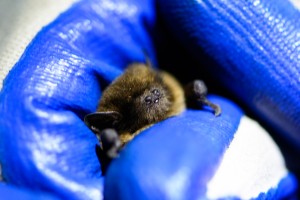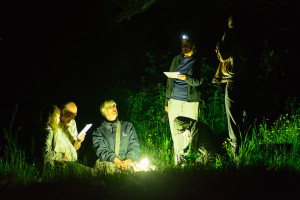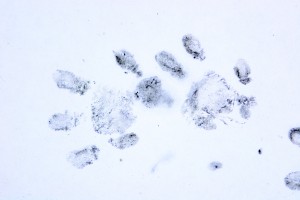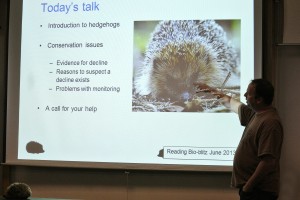What a weekend! As well as amazing weather, we were lucky to have so many enthusiastic people joining us at the first ever Whiteknights BioBlitz.
Friday night saw a large group gather for the start of the bat walk, run by the Berkshire Bat Group. The campus is excellent habitat for foraging bats and also a good place to roost, and many bats were seen overhead with their echolocation calls heard on the bat detectors. During the course of the bat walk (and another bat survey that was going on) six species of bat were detected. Friday night continued to amaze with a visit to see what the mist nets were catching. Mist nets, erected on poles, are a fine mesh that bats can’t detect, allowing us to catch them unharmed. During my brief visit I saw a soprano pipistrelle up close, which reminded me how small our British bat species are. People often think of the larger fruit bats or flying foxes when bats are mentioned, but our insectivorous bats are far smaller. A brown long-eared bat was also caught and released during the night.
The other exciting events on Friday night included the arrival of the Berkshire Moth Group, who put out four moth traps. Although it wasn’t a great night for moth trapping (not much cloud cover and a bit chilly!) we still had a good catch.

Torching for newts with the Berkshire Reptile and Amphibian Group where we found a good population of smooth newts
While walking between the moth traps, and watching the bats overhead, we popped over to the pond in the Harris Garden with a member of the Berkshire Reptile and Amphibian Group to do some newt hunting. Not expecting to find much we were delighted to see a good population of smooth newts, another nice find.
On Saturday many of us managed to get out of bed early to check the live small mammal traps that we had put out on Friday. It was lovely to see wood mice bounce out of the traps, and signs of hedgehogs on the footprint tunnels we had also put out. We had placed four camera traps the night before, and the Berkshire Mammal Group went through the video clips throughout Saturday, finding signs of red fox, pheasant and many other bird species.
Saturday flew past with a whirlwind of talks, walks and people visiting the environmental fair. The fair was well represented with stalls from the Berkshire Bat Group, Reading Friends of the Earth, Upper Thames Branch of Butterfly Conservation, Berkshire Moth Group, Reading and District Natural History Society, Wokingham and District Veteran Trees, Earley Environmental Group, Berkshire Reptile and Amphibian Group, Berkshire Ornithological Club and Berkshire Mammal Group. Dr M (Jonathan Mitchley!) was busy identifying plants, and other species experts were working on lichens, tardigrades, invertebrates, birds and many other groups. During the talks we were updated on the Berkshire Bird Atlas, informed about declines of pollinators, asked to participate in hedgehog monitoring and many myths about bats were dispelled (did you know that bats are more related to lemurs than rodents- so ignore that flying rat nonsense!!). The walks were varied, from children learning about birds to experts talking about plant pathogens, from bumblebee forays to wildflower meadow wanderings, people came back having enjoyed seeing the amazing diversity on campus.
The range of activities on the stalls was also varied, with much to see, from moths and caterpillars to a common pipistrelle bat which was being cared for by the Berkshire Bat Group (many bats are injured in cat attacks etc., and are cared for until they are ready to be released). Most stalls had a range of free leaflets and information on membership readily available.
Phil Baker gave a talk on his hedgehog monitoring project. If you weren’t able to make the BioBlitz then Dr M is currently editing his ‘eXtreme biodiversity’ video which should give you a good taste of what went on!
The event ended with many asking if it would be repeated next year. We spent the day amazed at how many amazingly keen amateur and expert naturalists there are in Berkshire and beyond, and how this event brought so many people together in their love of all wildlife. So our answer is why not! We are still working on putting the species list together, but we already know that it could be bettered next year; we hope to see you then!








It was a great 24 hours for biodiversity and for biodiversity enthusiasts! Looking forward to the results and the followup work!